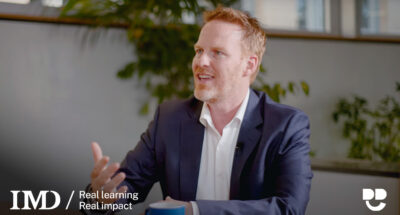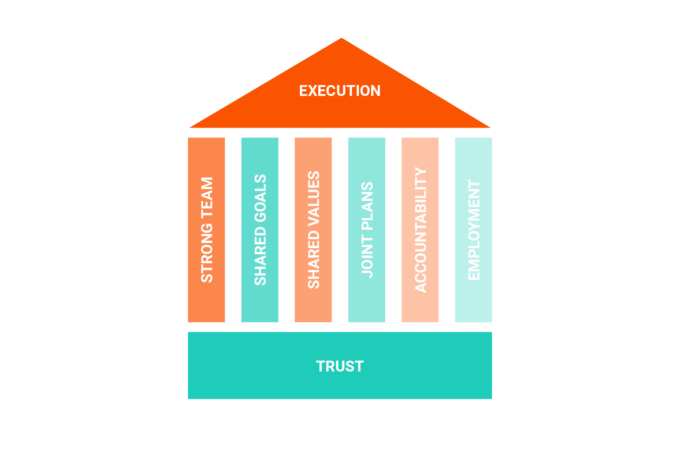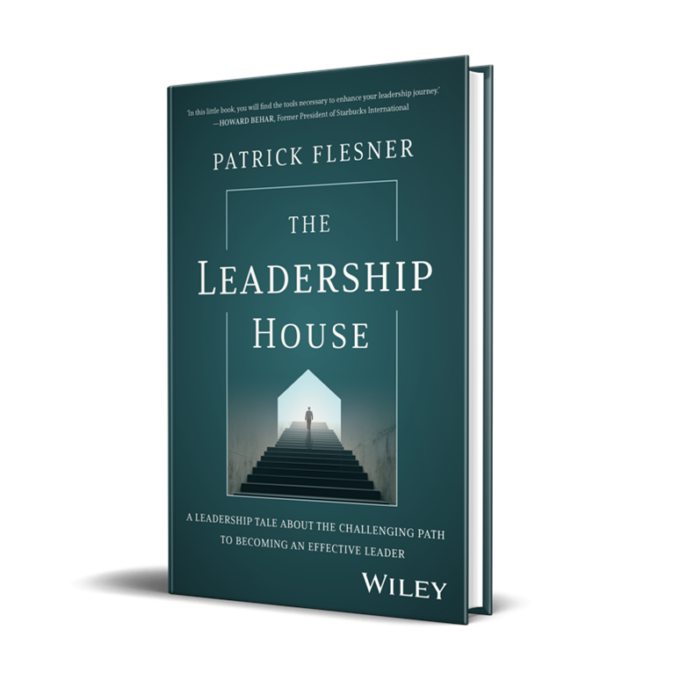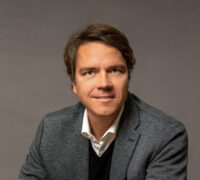
How does sustainable leadership work?
This episode takes you behind the scenes of a recent gathering led by the World Business Council for Sustainable Development together with IMD, where David Bach sat down with two sustainability leaders....

by Patrick Flesner Published November 18, 2024 in Leadership • 9 min read
In a recent survey, 7,000 leaders across 100 countries were asked if they possessed the capabilities to overcome future challenges. Only 17% were able to answer “yes” with total confidence. So, how do we become more effective leaders?
This statistic underscores a widespread uncertainty in leadership abilities. To address this issue, I have designed a comprehensive leadership development framework called “The Leadership House” to create the conditions for more effective leadership.
In this article, I give an overview of the framework (see my book The Leadership House for greater detail) as well as real-life examples of how it helped leaders become more effective.

The Leadership House is built on a solid foundation of trust. The power of trust first became apparent to me when I asked a leadership team what they believed was the main reason for their success. The CTO replied without hesitation: “We built trusting relationships with each other. We let our egos take a back seat. We always focus on what is best for the team.”
Trust provides a strong feeling of safety. In trusting relationships, it’s about the issue, not the person. In safe environments, we do not waste time and energy watching our backs or playing political games but focus on getting things done. We can give candid feedback, communicate honestly and transparently, and thrive.
In a rapidly growing global software company I worked with, the newly appointed CEO, Sarah, faced the challenge of uniting a leadership team that was missing deadlines and performance targets. At first, Sarah believed the team’s struggles were due to operational inefficiencies or mismatched skills. But after carefully observing the team dynamics, she realized the root issue wasn’t a lack of talent but a lack of trust.
Despite being highly capable, team members worked in silos, withholding critical information and avoiding open discussions, which led to miscommunication and internal friction. She recognized that trust must be built over time through consistent and authentic behavior and emphasized trust and teamwork as core shared values, making it clear that they needed to be at the heart of the company’s culture.
Sarah took a hands-on approach, implementing regular one-on-one meetings to understand individual concerns while promoting a culture of openness and transparency through team discussions. Crucially, she modeled vulnerability by sharing her leadership challenges and admitting mistakes. This allowed the team to feel safe doing the same, gradually breaking down barriers. Over time, as trust deepened, the leadership team stopped protecting their own interests and focused on collective success. Open communication, candid feedback, and collaboration became the norm. In less than a year, the company reversed its financial challenges and achieved a 25% revenue growth.
A strong team is the first pillar of The Leadership House. It’s about more than hiring the right people and putting them in the right roles.
Think about sports. We will often see teams with the best individual players lose against the underdogs. Teamwork can turn a group of even mediocre individuals into a strong unit. As James Hetfield of the heavy metal group Metallica observed: “I know individually we’re all really average players but when you put us together something happens. Something really happens.”
Recognizing the power of the following pillars of The Leadership House framework will help ensure that your great team members embrace teamwork and collaborate effectively.

“Invite team members to the goal-setting process and ask them about what they believe must be done to turn purpose and vision into reality. In this way, our team members will become the owners of the goals and do whatever possible to achieve them.”
Having the right people has two dimensions: the first is functional fit (Are our team members qualified for the roles?) and the second is cultural fit (Are our team members aligned around shared values in terms of how we want to work together?).
A strong culture is a competitive advantage and separates the best teams from the rest, a fact confirmed by a McKinsey study of more than 1,000 organizations.
For instance, at a rapidly scaling retail company I worked with, the CEO, Mark, faced a growing challenge. Employee morale was low, turnover was high, and departments operated in silos. Despite having a clear business strategy, the company was struggling. Mark recognized that the root of the problem wasn’t just operational – it was cultural. He decided to embark on a cultural transformation journey using the Culture Compass Framework to guide him.
First, Mark conducted a Culture Scan, gathering employee feedback through surveys and focus groups. He discovered a major disconnect: while the leadership emphasized innovation, the company’s culture was risk-averse, stifling creativity.
With this insight, Mark moved to the next step, Culture Match. He hosted workshops across the organization, defining shared values like collaboration, transparency, and accountability that aligned with the company’s vision for innovation.
Mark then implemented the Culture Shift by rolling out initiatives that encouraged open communication and rewarded risk-taking. He also ensured leadership modeled the desired behaviors, championing collaboration at every level.
Lastly, Mark knew the change needed to be sustainable. He established a Culture Shield, conducting regular culture audits and reinforcing the new norms through ongoing engagement.
In less than two years, the transformation was clear. Employee satisfaction improved, silos broke down, and the company’s innovative capabilities flourished. Mark’s commitment to driving cultural change ensured the company didn’t just succeed in the short term but thrived with a strong, unified culture built on purpose, vision, and shared values.
Purpose and vision are important but almost always intangible. It is vital to clarify what must be done to achieve your company’s vision and turn it into reality.
A leader’s job is no longer to “know the way, show the way, and go the way.” This widespread belief is outdated. In our fast-paced and ever-changing business environment, the leader’s job is to build a strong team and, together, find the way and walk the way.
We should invite team members to the goal-setting process and ask them about what they believe must be done to turn purpose and vision into reality. In this way, our team members will become the owners of the goals and do whatever possible to achieve them, which is psychologically very powerful.

“Through a series of collaborative sessions, the leadership team worked together to identify the shared goals they needed to achieve to turn vision into reality.”
We must ask our teams to translate shared goals into “joint plans” – the next pillar of The Leadership House. We must show what each team and its members must do (and, importantly, deliver in terms of results) so we achieve our shared goals. Joint plans are more granular and make execution possible.
At a mid-sized tech company, the CEO, Emma, was struggling to solve the company’s mounting problems. She believed it was her responsibility to have all the answers and to dictate the team’s direction. Despite her best efforts, the company continued to miss growth targets, and projects routinely fell behind. Only when Emma realized that she didn’t need to have all the answers herself – that she had a great team with valuable experience and insights – did the situation improve. By involving the team in the problem-solving and goal-setting process, Emma could tap into their collective knowledge and experience. Through a series of collaborative sessions, the leadership team worked together to identify the shared goals they needed to achieve to turn vision into reality.
However, the real breakthrough came when they took these shared goals and turned them into a joint plan that laid out the tasks of each team member and the deliverables for which they were responsible. With shared goals and a clear joint plan in place, the company was not only back on track but exceeded growth targets by 15%, proving that a leader’s true strength often comes from leveraging the collective wisdom of the team.
Team members are held accountable for both the tasks and the results they achieve. This is why it is so important that joint plans also show the results to be delivered. If joint plans only show responsibilities but not the expected results, team members might say, “It’s not my fault that we didn’t achieve our joint plan. I’ve done what I was supposed to do,” or “This is not my responsibility.” You won’t hear these things in teams that embrace accountability as a shared value. Accountability encourages teamwork. Team members will ask for help if they realize they may not achieve the expected results, and they will offer help if a colleague is struggling.
Some leaders shy away from holding their team members accountable because they feel uncomfortable leading these crucial conversations. But, as we have seen, in safe environments based on trust, team members know it is about resolving the issue and targeting success, not apportioning blame.
Consider Emma again. Once she and her team had developed a joint plan, it became clear why outlining specific deliverables in joint plans was essential. As Emma started holding her team accountable for their specific deliverables, something remarkable happened: instead of resisting, the team embraced it. They understood that it wasn’t about placing blame but ensuring collective success. This clarity empowered each team member to own their responsibilities and deliverables. More importantly, they started holding each other accountable. This culture of mutual accountability brought the team closer together, strengthened collaboration, and led to them surpassing their growth targets.
We can only hold team members accountable if we empower them. This is why “empowerment” is the last pillar of the house.
The detail that makes empowerment so powerful is that we enable team members to make important decisions themselves.
That may make us feel as if we are losing control, but empowerment is about motivating and giving control to those best equipped to handle it – our teams.

The roof of The Leadership House is Execution, where everything comes together. Without execution, there are no results; without results, there is no effective leadership. Execution is where leadership shifts from theory to practice, yet it’s often where leaders struggle the most.
One of the key challenges is finding the right level of involvement – too much oversight risks micromanagement, stifling creativity and independence. Too little involvement leads to confusion and a lack of direction. If you find yourself struggling to strike a balance between stepping in and stepping back, you may find my “Leadership Scale” framework helpful. It’s a tool I’ve shared in my book and another article to guide leaders through this challenge.
Another common challenge in the execution phase is self-doubt in decision-making. The pressure to be right can be overwhelming, especially when the stakes are high. But remember: no leader has all the answers, and that’s fine. Leadership isn’t about knowing everything but about creating the conditions for your team to find the answers together. In life and business, outcomes depend on external factors, and, often, a bit of luck. What we can influence and control is building a great team, setting it up for success, and working together toward shared goals. The Leadership House framework provides the structure to do just that.
The framework has helped many leaders turn their visions into reality. It will help you systematically develop your leadership skills, transform your teams, and drive your organization toward success.
My book addresses the confidence gap among leaders and provides a clear, structured path to becoming a highly effective leader, one who turns followers into leaders and elevates the entire organization.

Leadership and Executive Coach
Patrick Flesner is a seasoned leadership and executive coach, a former professional handball player in the Handball-Bundesliga, a recognized bestselling author, and a renowned expert in the field of leadership. His diverse background, which includes experiences in top-level sports, roles as a partner in prestigious German law firms, a leadership position in a publicly traded company, and as a partner in a venture capital fund, has endowed him with a comprehensive and multifaceted perspective on leadership. Flesner’s growth mindset leadership philosophy – a central theme in his books The Leadership House – The Challenging Path to Becoming an Effective Leader and FastScaling – The Smart Path to Building Massively Valuable Businesses as well as in his LinkedIn Newsletter, Leadership Shots – extends to his various publications, keynotes, and his TEDx talk “How to Become an Effective Leader”. This ethos is the cornerstone of Unloq Growth, his advisory firm specializing in growth mindset-leadership. He is the author of the best-selling high-growth handbook for founders FastScaling and the leadership guide Leading Effectively.

April 17, 2025 • by David Bach, Felix Zeltner in Leadership
This episode takes you behind the scenes of a recent gathering led by the World Business Council for Sustainable Development together with IMD, where David Bach sat down with two sustainability leaders....

April 17, 2025 • by Michael Skapinker in Leadership
All organizations should have a plan to secure trust during, after (and even before) a crisis hits. Here are a host of examples, good and bad, to learn from....
 Audio available
Audio available
April 15, 2025 • by Knut Haanaes in Leadership
Writing reports that go unread, weekends wasted working on non-essential tasks, and unrealistic targets that can never be met. Top talent is being left exhausted and demoralized. Here are seven ways to...

April 11, 2025 • by Michael D. Watkins in Leadership
Michael Watkins outlines the simultaneous need for acuity and inner rootedness – what he calls Grounded Edge Leadership – to navigate increasing change and uncertainty....